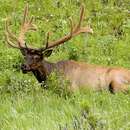Biology
provided by Arkive
Stags and hinds tend to stay in separate groups for most of the year (1); stags group into unrelated 'bachelor herds', and hinds live in groups consisting of a dominant female and her daughters (1). They are active throughout the 24-hour period, but tend to be more so in the evening and at night, possibly due to human activity (4). The diet consists of shrub and tree browse (4), grasses, sedges and rushes (1), as well as heather (4).
Mating occurs between late September and November (1), during this time, known as 'the rut', mature stags invest much time and effort into competing with other males for access to females at traditional rutting areas (1). Roaring contests and parallel walking allow males to 'size each other up' without violence; evenly matched stags may then escalate the contest and lock antlers, push each other and try to throw their opponent off-balance by twisting, sometimes leading to serious injuries and even death (5). After the rutting period, males and females go their separate ways. Births, usually of a single young (3), occur from late May and peak towards the beginning of June (4). Male offspring disperse when they reach one or two years of age, but female calves usually stay with their mother (4).
Conservation
provided by Arkive
There is no conservation action targeted at this widespread and common species, although populations are carefully managed to maintain health and keep a balance with the environment (3).
Description
provided by Arkive
Red deer are the largest native land animal to occur in the UK (2). Stags (males) are larger in size than hinds (females), and have magnificent branched antlers that can reach up to 1m in width (2). The coat is reddish-brown in colour in summer but becomes brown or grey in winter (3), and there is a cream coloured rump patch (1).
Habitat
provided by Arkive
This species occupies a range of habitats including grassland, woodland and upland moors (4).
Range
provided by Arkive
Red deer are patchily distributed in the UK; they are widespread and locally common in northern Scotland. Populations in Scotland and the north-west of England represent native stock, whereas in south-west Scotland and most of England they are likely to be escapees from deer parks (4). In many areas, populations of this species are thought to be on the increase (4), but numbers in Wales are low (4).
Status
provided by Arkive
Classified as a Species of Conservation Concern under the UK Biodiversity Action Plan, but not a priority species (7). Certain methods of killing or capture are prohibited under Appendix IV of the Bern Convention (8). Red deer are protected in the UK by the Deer Act 1991 (9).
Threats
provided by Arkive
A major threat to our native red deer is thought to be hybridisation resulting from crossbreeding with the introduced sika deer, Cervus nippon (1). The red deer is culled to restrict the damage it causes to forestry, agriculture and the natural environment (e.g. browsing can prevent the regeneration of woodland) (4). Trophy hunting and hunting for meat (venison) are also common (4).

